DNEA Digital New Energy Africa | Innovative Solutions for Sustainable Power & Wind Turbines
- 010 824 1395
- 084 817 8179
- info@dnea.co.za
- Warranty Disclaimer and Claim Policy
Wind Turbine Vertical 5 Blade 500W 48V with MPPT Controller
R8900,00
DNEA’s Role in Horizontal and Vertical Wind Turbines
DNEA’s expertise extends to both horizontal and vertical wind turbines, ensuring that homeowners have access to a diverse range of options tailored to their specific needs and the local environment.
Description
Whether you’re living in a rural area and don’t have access to an electric grid or are living in a suburb and looking to reduce your utility bill, home wind turbines are a great solution to complemement your solar system. All that’s required is a little know-how, some space and a pole or mast. From around R 6000, you can buy yourself a mid-range home wind turbine that can comfortably meet your needs when no sun is available in overcast days or at night.
Features:
500W 48V Vertical 5 Blade with Digital MPPT Controller Included
1.Low start up wind speed, compact, light, beautiful and with lowest available vibration and minimal noise levels.
2.Easy installation, flange connection and all bolts nuts + Fixing included
3.Blades using nylon fiber matched with optimized aerodynamic shape and structure. UVA UVB Protected White colour
4.Patented permanent magnet ac generator with special stator(maglev generator),effectively reduce torque, make only 1/3 torque of ordinary
generator, well matched to the African wind conditions wind wheel and generator, ensuring the ultimate performance of complete system.
5.Adopting Digital MPPT intelligent micro controller effectively adjusts current and voltage to optimum levels.
|
Model
|
DNeA-500 Vertical Ball Type
|
|
Rated power
|
500W
|
|
Maximum power
|
510W
|
|
Rated voltage
|
48V
|
|
Start up wind speed
|
2m/s
|
|
Rated wind speed
|
12m/s
|
|
Survival wind speed
|
45m/s
|
|
Top net weight
|
12kg
|
|
Wheel diameter
|
0.9m
|
|
Blades number
|
5 |
|
Blades material
|
Reinforced glass fiber
|
|
Generator
|
Three phase permanent magnet ac generator
|
|
Magnetic steel
|
NdFeB
|
|
Generator case
|
Die-casting aluminum
|
|
Control system
|
Electromagnet/ wind wheel yaw
|
|
Speed regulation
|
Automatically adjust windward
|
|
Working temperature
|
-40℃~80℃
|
|
Lubrication
|
Grease injection
|
DNEA’s Role in Horizontal and Vertical Wind Turbines
DNEA’s expertise extends to both horizontal and vertical wind turbines, ensuring that homeowners have access to a diverse range of options tailored to their specific needs and the local environment.
- Horizontal Turbines: As the largest local distributor, DNEA provides homeowners with access to high-quality horizontal wind turbines renowned for their efficiency and reliability. The technical team at DNEA can guide homeowners in selecting the optimal horizontal turbine for their location and energy requirements.
- Vertical Turbines: Recognizing the unique advantages of vertical wind turbines, DNEA offers a selection of vertical turbines suitable for residential applications. The company’s technical team can provide insights into the benefits of vertical turbines in specific wind conditions, helping homeowners make informed decisions.
Wind turbines have become a prominent symbol of clean, renewable energy, dotting landscapes across the globe as an efficient means of generating electricity. While large-scale wind farms contribute significantly to the global shift towards sustainable energy, residential wind turbines are gaining popularity as an effective solution for individuals seeking to harness wind power on a smaller scale. In this essay, we will delve into the workings of residential wind turbines, exploring how these innovative devices generate home energy and contribute to a greener, more sustainable future.
Wind turbines are mechanical devices designed to convert the kinetic energy of the wind into electrical energy. They consist of various components that work seamlessly together to capture and harness the power of the wind. When it comes to residential wind turbines, the principles are similar to those used in larger-scale wind farms, but the scale and design are adapted to suit the needs of individual homeowners.
One key component of a residential wind turbine is the rotor, which is comprised of two or more blades attached to a hub. These blades are aerodynamically designed to capture the maximum amount of wind energy as they rotate. The rotor is connected to a shaft, which in turn is connected to a generator. As the wind blows, it causes the blades to spin, and this rotational movement is transferred to the generator through the shaft.
The generator within the wind turbine is a crucial element responsible for converting the rotational energy from the rotor into electrical energy. Residential wind turbines typically use either synchronous generators or asynchronous generators, each with its own advantages and disadvantages. Synchronous generators are more common in larger wind turbines, while asynchronous generators are often employed in smaller-scale residential applications due to their simplicity and cost-effectiveness.
To maximize energy output, the wind turbine is mounted atop a tower to elevate the rotor into higher, more consistent wind speeds. The height of the tower is critical, as wind speeds tend to increase with altitude, allowing the turbine to capture more energy. The tower also serves the purpose of keeping the blades at a safe distance from the ground and other structures.
Wind turbines are equipped with a mechanism called a yaw system, which enables the rotor to face into the wind. This ensures that the blades capture the maximum amount of wind energy and operate at peak efficiency. The yaw system can either be passive, relying on the wind’s force to align the turbine correctly, or active, using a motorized system to adjust the turbine’s orientation based on wind direction.
Residential wind turbines are designed with the homeowner’s energy needs in mind. These systems are typically grid-tied, meaning they are connected to the local electrical grid. When the wind turbine generates more electricity than the household consumes, the excess energy can be fed back into the grid, earning the homeowner credits or compensation from the utility company. Conversely, during periods of low wind or high energy demand, the homeowner can draw electricity from the grid.
An important consideration for residential wind turbines is the wind resource at the installation site. The success of these systems heavily relies on the average wind speed and consistency in the area. Homeowners should conduct a thorough wind resource assessment before investing in a wind turbine to ensure its viability and effectiveness.
Maintenance is another aspect to consider when installing a residential wind turbine. While these systems are generally robust and durable, routine inspections and occasional repairs may be necessary. Regular checks of the blades, tower, and other components can prevent issues from escalating and ensure the longevity of the system.
Residential wind turbines offer several advantages to homeowners looking to reduce their carbon footprint and energy bills. First and foremost, they harness a clean and renewable source of energy – the wind. Unlike fossil fuels, wind power does not produce harmful greenhouse gas emissions, making it an environmentally friendly choice for those committed to sustainability.
Moreover, residential wind turbines can significantly lower electricity costs over the long term. While the initial investment may be higher than other renewable energy options, such as home solar panels, the ongoing operational costs are relatively low. Once installed, wind turbines generate electricity at no additional cost, providing a reliable and cost-effective source of power for years to come.
Homeowners also benefit from the potential to earn money through net metering. Excess electricity generated by the wind turbine can be fed back into the grid, allowing homeowners to receive credits or compensation from their utility provider. This not only helps offset the initial investment but also contributes to the overall grid’s stability and sustainability.
In comparison to home solar systems, residential wind turbines have distinct advantages in certain regions and conditions. While solar panels rely on sunlight, wind turbines can generate electricity day and night, as long as there is sufficient wind. This makes wind turbines particularly advantageous in areas with variable weather patterns or during seasons with less sunlight.
Now, let’s delve into the importance of wind turbines in the broader context of home energy. Home energy solutions, including wind turbines, play a pivotal role in the transition towards a more sustainable and environmentally conscious way of living. As the global community grapples with the challenges of climate change and dwindling fossil fuel reserves, the emphasis on renewable energy sources becomes increasingly critical.
Wind turbines, along with home solar systems, exemplify a decentralized and distributed approach to energy production. Instead of relying solely on centralized power plants that often burn fossil fuels, homeowners can actively participate in generating their own electricity. This shift towards decentralized energy production contributes to a more resilient and adaptive energy infrastructure, reducing the reliance on large-scale power plants that are susceptible to disruptions and failures.
The integration of wind turbines and home solar systems represents a holistic approach to meeting residential energy needs. Depending on the specific environmental conditions at a given location, homeowners can choose the most suitable combination of renewable energy sources. Wind turbines are particularly effective in regions with ample wind resources, while solar panels excel in sunnier climates. By combining these technologies, homeowners can create a robust and reliable renewable energy system that maximizes efficiency and minimizes environmental impact.
The rise of residential wind turbines aligns with the broader movement towards sustainable living and eco-friendly practices. Individuals and communities around the world are increasingly recognizing the importance of reducing their carbon footprint and embracing renewable energy solutions. The installation of wind turbines at the residential level signifies a tangible commitment to sustainability and a proactive contribution to mitigating the impacts of climate change.
In conclusion, residential wind turbines are an innovative and effective means of harnessing wind power to generate home energy. These devices, equipped with aerodynamically designed rotors, generators, and yaw systems, convert the kinetic energy of the wind into clean, renewable electricity. Mounted on towers to capture higher wind speeds, these turbines contribute to a decentralized and distributed energy production model.
The advantages of residential wind turbines are numerous, ranging from lower electricity costs and potential earnings through net metering to a reduced carbon footprint and increased energy independence. When combined with home solar systems, wind turbines offer a comprehensive and flexible solution to meet residential energy needs. As individuals and communities worldwide increasingly prioritize sustainability, the adoption of residential wind turbines represents a meaningful step towards a greener and more sustainable future.
In conclusion, residential wind turbines represent a pivotal solution in the transition towards sustainable and renewable energy. DNEA’s role as the largest local importer and distributor, coupled with its technical expertise, ensures that homeowners have access to state-of-the-art wind turbine solutions tailored to their unique needs. The availability of different voltage systems (12V, 24V, and 48V) further enhances the versatility of residential wind turbines, allowing homeowners to choose the most appropriate system for their energy demands.
By delving into the distinctions between horizontal and vertical wind turbines, this essay has highlighted how DNEA’s commitment to innovation and accessibility positions it as a leader in providing comprehensive wind energy solutions. As homeowners increasingly seek to harness the power of the wind for their energy needs, DNEA stands as a reliable partner in fostering a more sustainable and resilient future, one wind turbine at a time.
All DNeA’s Vertical Wind turbines come with MPPT Charge Controllers included for the most efficient wind systems.
|
DNeA-500W Ball TYPE vertical
|
|
|
Rated power
|
500W
|
|
Rated voltage
|
48V
|
|
Wheel diameter
|
0.9m
|
|
Blade number
|
5pcs
|
|
Start wind speed
|
2m/s
|
|
Blade material
|
Nylon fiber
|
|
Control system
|
Electromagnet
|
|
Working temperature
|
-40℃~80℃
|
Product features
Multiple Wind and Draft directions
1.Super Silent Low start up speed, high wind energy utilization, beautiful appearance, low vibration, low sound db levels;
2.Efficient friendly design, easy installation, maintenance and repair;
3.Precise injection molding blades together with the optimized design of aerodynamic contour and structure, the blades have the best in industry levels of high utilization of wind energy which contributes to the annual highest energy creation from wind sources.
4.The generators, adopting patented permanent magnet rotor alternator, with the latest and most modern kind of stator design, efficiently decreases resistance torque, while, making the wind turbines blades and structure matching the generator quite very well and increase its reliability and proformance.
5.Aluminum alloy body, anti-corrosion treated, resistant to acid and alkali, applicable in salty environment eg: Coastal areas.

|
Model
|
DNeA-500 Vertical Ball Type
|
|
|
Rated power
|
500W
|
|
|
Maximum power
|
510W
|
|
|
Rated voltage
|
48V
|
|
|
Start up wind speed
|
2m/s
|
|
|
Rated wind speed
|
12m/s
|
|
|
Survival wind speed
|
45m/s Automatic BreakIn Protection 45m/s
|
|
|
Top net weight
|
12kg
|
|
|
Wheel diameter
|
0.9m
|
|
|
Blades number
|
5
|
|
|
Blades material
|
Reinforced glass fiber
|
|
|
Generator
|
Three phase permanent magnet ac generator
|
|
|
Magnetic steel
|
NdFeB
|
|
|
Generator case
|
Die-casting aluminum
|
|
|
Control system
|
Electromagnet
|
|
|
Speed regulation
|
Automatically adjust windward
|
|
|
Working temperature
|
-40℃~80℃
|
|
RELATED PRODUCTS
Related products
-
Sale!
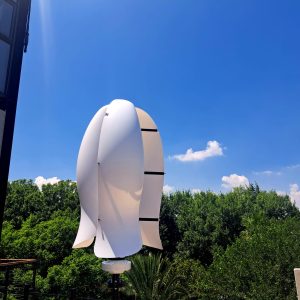
Wind Turbine Vertical 3 Blade 1000W 48V with MPPT Controller 2025 Model
R21500,00Original price was: R21500,00.R19900,00Current price is: R19900,00. Request Quote -
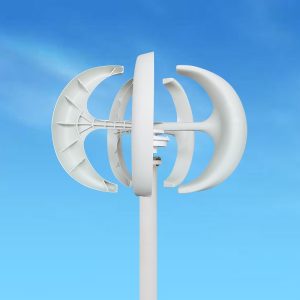
Wind Turbine Vertical 5 Blade 400W 12/24V with MPPT Controller
R7900,00 Request Quote -
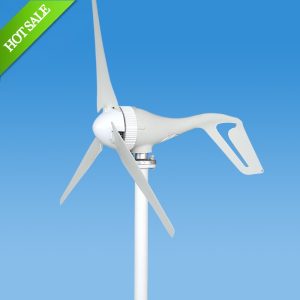
Wind Turbine Horizontal 5 Blade 500W 48V with MPPT Controller
R8900,00 Request Quote -
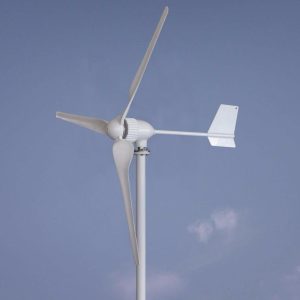
Wind Turbine Horizontal 3 Blade 1000W 48V with MPPT Controller
R16900,00 Request Quote -

Wind Turbine Horizontal 5 Blade 400W 12/24V with MPPT Controller
R7900,00 Request Quote -
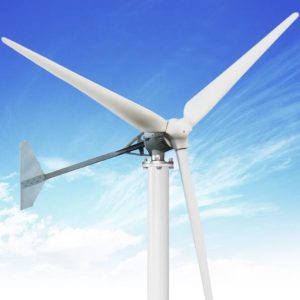
Wind Turbine Horizontal 3 Blade 2000W 48V with MPPT Controller
R34900,00 Request Quote

